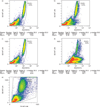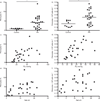Circulating fibrocytes are increased in children and young adults with pulmonary hypertension
- PMID: 21700605
- PMCID: PMC3319160
- DOI: 10.1183/09031936.00072311
Circulating fibrocytes are increased in children and young adults with pulmonary hypertension
Abstract
Chronic inflammation is an important component of the fibroproliferative changes that characterise pulmonary hypertensive vasculopathy. Fibrocytes contribute to tissue remodelling in settings of chronic inflammation, including animal models of pulmonary hypertension (PH). We sought to determine whether circulating fibrocytes were increased in children and young adults with PH. 26 individuals with PH and 10 with normal cardiac anatomy were studied. Fresh blood was analysed by flow cytometry for fibrocytes expressing CD45 and procollagen. Fibrocyte numbers were correlated to clinical and haemodynamic parameters, and circulating CC chemokine ligand (CCL)2 and CXC chemokine ligand (CXCL)12 levels. We found an enrichment of circulating fibrocytes among those with PH. No differences in fibrocytes were observed among those with idiopathic versus secondary PH. Higher fibrocytes correlated to increasing mean pulmonary artery pressure and age, but not to length or type of treatment. Immunofluorescence analysis confirmed flow sorting specificity. Differences in plasma levels of CCL2 or CXCL12, which could mobilise fibrocytes from the bone marrow, were not found. We conclude that circulating fibrocytes are significantly increased in individuals with PH compared with controls. We speculate that these cells might play important roles in vascular remodelling in children and young adults with pulmonary hypertension.
Figures



Comment in
-
The fibrocyte in pulmonary hypertension: we seek him here, we seek him there.Eur Respir J. 2012 Jan;39(1):5-6. doi: 10.1183/09031936.00127111. Eur Respir J. 2012. PMID: 22210809 No abstract available.
References
-
- Humbert M. Update in pulmonary hypertension 2008. Am J Respir Crit Care Med. 2009;179:650–656. - PubMed
-
- Junhui Z, Xingxiang W, Guosheng F, et al. Reduced number and activity of circulating endothelial progenitor cells in patients with idiopathic pulmonary arterial hypertension. Respir Med. 2008;102:1073–1079. - PubMed
Publication types
MeSH terms
Substances
Grants and funding
LinkOut - more resources
Full Text Sources
Other Literature Sources
Medical
Research Materials
Miscellaneous
